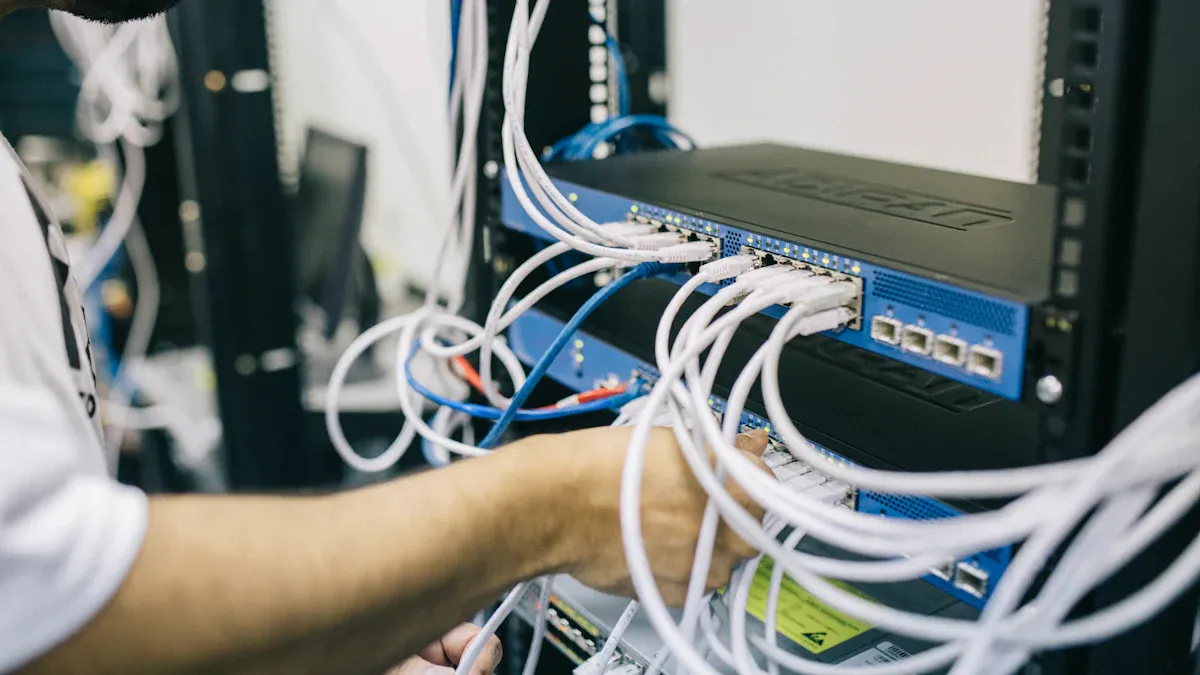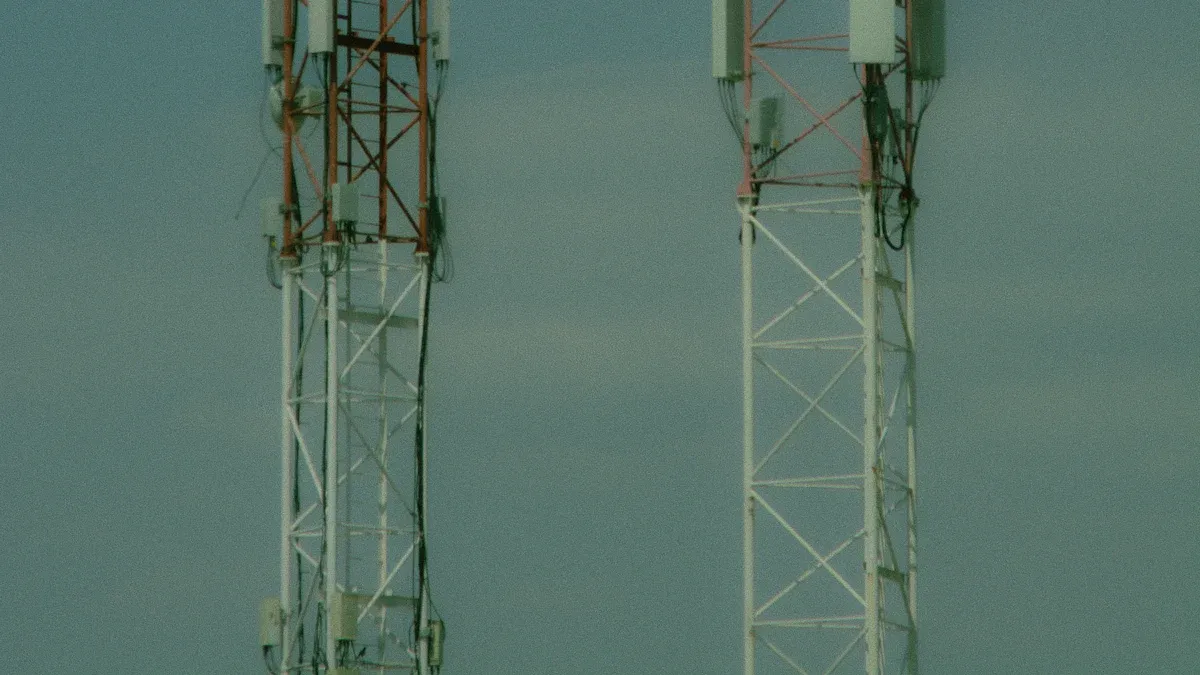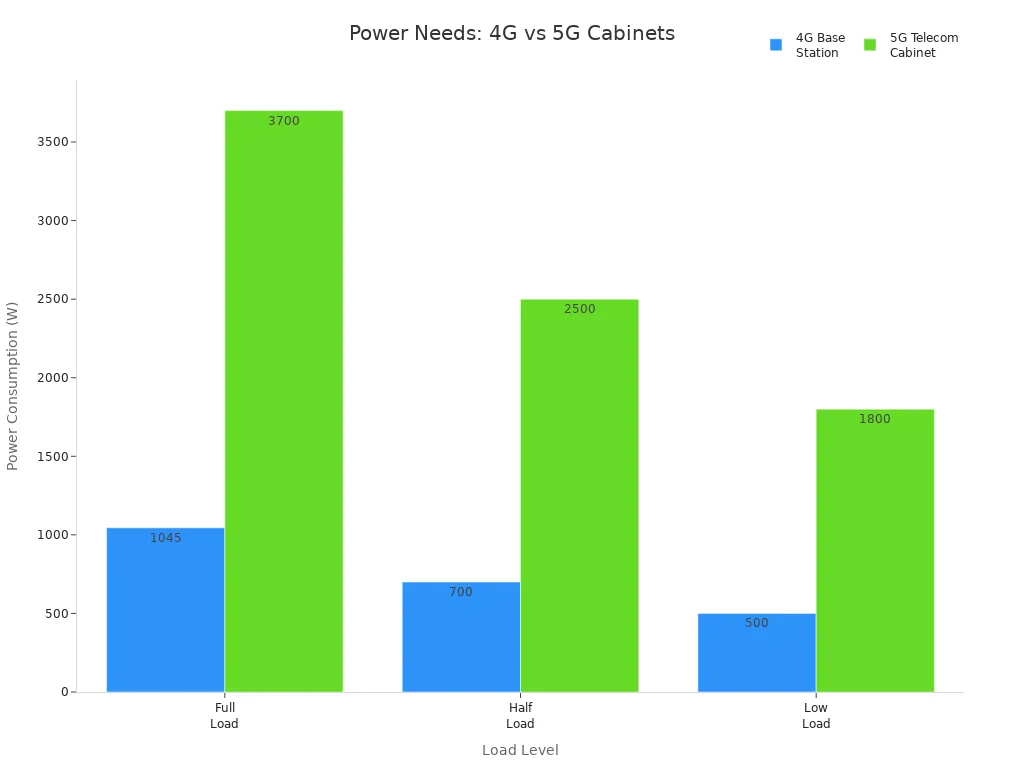5G Telecom Cabinet Power Controllers: Why MQTT-Enabled Smart Controllers Better Adapt to Cloud Platforms?

MQTT-enabled smart controllers transform how a Telecom Cabinet Power Controller connects to the cloud. These controllers deliver real-time data using low bandwidth, maintain secure communication with TLS encryption, and support seamless integration across public and private clouds.
Developers highlight fast, scalable performance and easy extensibility.
Security features like TPM and remote attestation ensure device integrity.
AI-powered predictive alerts and modular components boost reliability and efficiency. This approach future-proofs telecom infrastructure and reduces downtime.
Key Takeaways
MQTT-enabled smart controllers provide fast, secure, and efficient communication for 5G telecom power systems, supporting real-time data and reducing network load.
These controllers improve reliability and uptime by enabling predictive maintenance and remote monitoring, which lowers downtime and maintenance costs.
Modular and scalable designs help telecom cabinets handle higher 5G power demands while allowing easy upgrades and integration with renewable energy sources.
Cloud integration with MQTT simplifies device management, reduces hardware needs, and supports flexible, scalable control from anywhere.
Strong security features like TLS encryption and device authentication protect sensitive data and ensure safe operation in complex telecom networks.
Power Management Needs

5G Demands
5G networks introduce much higher power requirements compared to previous generations. The equipment inside telecom cabinets must support increased data rates, more antennas, and edge computing resources. The following table highlights the difference in power consumption between 4G and 5G telecom cabinets at various load levels:
Load Level | 4G Power Consumption (W) | 5G Power Consumption (W) |
|---|---|---|
Full Load | 1,045 | 3,700 |
Half Load | 800 | 2,600 |
Low Load | 600 | 1,800 |

5G telecom cabinets require scalable rectifiers and modular designs to handle these higher loads. Operators often integrate renewable energy sources, such as solar panels and lithium iron phosphate batteries, to ensure reliable power in remote areas. Hybrid systems that combine solar, grid, and diesel backup help optimize efficiency and reliability. Effective thermal management becomes essential because dense 5G equipment generates significant heat. Power distribution systems must support both AC and DC, with surge protection to guard against lightning and power surges. Modular layouts allow for hot-swappable components, making it easier to adapt to evolving network demands.
Note: The global telecom power system market is projected to reach $8.54 billion by 2031, reflecting the growing complexity and scale of 5G deployments.
Traditional Controller Limits
Traditional power controllers face several challenges in meeting the needs of modern 5G telecom cabinets:
Lower efficiency and power density, making them unsuitable for high-power, compact environments.
Excessive heat generation, which older cooling methods cannot manage effectively.
Lack of modularity and scalability, limiting flexibility for dense network deployments.
Larger physical footprint, restricting equipment installation in space-constrained urban sites.
Inadequate cooling solutions, such as passive airflow or basic fans, which cannot handle the heat from high-density setups.
Inability to meet strict efficiency and power density standards, hindering support for advanced 5G features.
These limitations show why operators now require advanced solutions like the modern Telecom Cabinet Power Controller. New designs use wide bandgap semiconductors to improve efficiency, reduce heat, and enable modular, scalable deployments for 5G networks.
MQTT in Telecom Cabinet Power Controller

MQTT Basics
MQTT stands out as a lightweight messaging protocol designed for machine-to-machine communication. It uses a broker-mediated publish/subscribe model, which decouples devices in both space and time. This architecture allows asynchronous operation, so devices do not need direct peer-to-peer connections. The protocol supports scalable and real-time data exchange, which is essential in environments where multiple devices and legacy systems coexist. Telecom Cabinet Power Controller applications benefit from MQTT because it minimizes data transmission overhead with a compact header and simple interactions. Devices can subscribe only to relevant topics, which reduces unnecessary data flow and optimizes bandwidth usage.
MQTT supports three Quality of Service (QoS) levels. These levels ensure reliable message delivery, even in networks that experience interruptions or have limited resources. The protocol's flexibility allows integration of diverse devices and protocols, making it suitable for telecom cabinets that require efficient and reliable data transmission.
MQTT is data-agnostic, which means it can handle various types of information.
The protocol operates efficiently on resource-constrained devices, such as ESP8266 modules.
Experimental studies show MQTT reduces power consumption by a factor of 3.3 compared to other architectures.
Real-Time Data & Security
Real-time data transmission is critical for monitoring and controlling power systems in telecom cabinets. MQTT enables this by using minimal packet sizes and persistent sessions. Devices maintain connections with low bandwidth and latency, which is vital for cellular IoT technologies like NB-IoT and Cat-M1. MQTT-SN, a variant of MQTT, further optimizes communication for ultra-low bandwidth and resource-constrained devices by using topic ID registration and operating over UDP.
Research highlights that MQTT extensions introduce priority control mechanisms. Brokers manage communication based on application QoS requirements, which reduces latency and increases successful message delivery ratios. Integrating MQTT with Software Defined Networking allows network-level resource reservation and prioritization, minimizing delays and ensuring timely data transmission.
Security remains a top priority in telecom environments. MQTT uses security certificates and supports encrypted connections, such as TLS, to protect data in transit. The broker-based architecture enables scalable and secure communication, which is essential for the Telecom Cabinet Power Controller. Stable voltage and power consumption metrics have been demonstrated in case studies, showing that MQTT facilitates efficient energy usage and cost reduction in power management infrastructures.
Controller Comparison
Cloud Integration
Cloud integration defines how easily a controller connects and communicates with cloud platforms. MQTT-enabled smart controllers offer several advantages over traditional controllers:
MQTT uses a lightweight protocol that works well in low bandwidth and energy-efficient environments.
The publish-subscribe model reduces message overhead and enables faster communication with cloud services.
MQTT-based systems, such as those using ESP8266 microcontrollers, achieve response times of 1-2 seconds in real-world trials.
These controllers ensure reliable data transmission with minimal loss, supporting agile and scalable cloud integration.
Cloud computing offloads heavy processing from the device, allowing simpler hardware and easier integration.
Traditional controllers often require complex installation, configuration, and maintenance. They depend on dedicated hardware and extensive wiring, which slows deployment and increases complexity. In contrast, cloud-based controllers eliminate the need for physical hardware controllers. Administrators can manage these controllers remotely through web browsers, enabling faster configuration and troubleshooting. Cloud solutions also reduce total cost by leveraging shared infrastructure and minimizing hardware and maintenance expenses.
A comparison of technical requirements for integrating MQTT-enabled smart controllers with major cloud platforms appears in the table below:
Technical Requirement | Description |
|---|---|
Secure Authentication & Credential Management | Device credential stores managed locally or via managed DB services; integration with IAM recommended. |
Bidirectional MQTT Messaging | Support for both data ingestion and command/control via MQTT topics. |
Topic Hierarchy Design | Separate topics for data and commands to organize message routing. |
Edge-to-Cloud Integration | Local MQTT brokers can connect to cloud brokers for secure, bidirectional communication. |
Multiple QoS Levels | Support MQTT QoS levels to ensure message delivery reliability. |
Hardware and Software Encryption | Use TLS encryption and hardware-based encryption for data security. |
Flexible Data Integration Methods | Support RESTful APIs, JSON, XML, and MQTT protocol for data exchange. |
Cloud-Native Service Integration | Seamless integration with Google Cloud Pub/Sub, AWS IoT Core, Azure IoT Hub, etc. |
Multi-Destination Data Flows | Enable data routing to analytics, AI inference, storage, and other downstream systems. |
MQTT-enabled devices support open communication protocols, allowing interoperability across manufacturers. Cloud services centralize infrastructure, reducing local device complexity and cost. Devices communicate securely with cloud services, enabling remote control via smartphones, tablets, or web browsers. Cloud connectivity also allows integration with third-party services, enhancing functionality and ease of use.
Data Handling
Data handling describes how controllers collect, transmit, and process information. MQTT-enabled smart controllers use a binary-based protocol that optimizes message size and minimizes bandwidth consumption. This approach makes them ideal for environments with limited network capacity. MQTT supports three Quality of Service (QoS) levels, ensuring reliable message delivery. QoS 2 guarantees exactly-once delivery, which is important for critical power management data.
The protocol operates over TCP/IP and uses a publish-subscribe model. This model decouples publishers and subscribers, allowing asynchronous communication and reducing network congestion. The payload typically carries application data in a compact binary format. Security features include username/password authentication, client certificates, and TLS/SSL encryption. These features make MQTT over TCP/IP with optional TLS the primary protocol and data format for cloud communication in smart controllers.
Traditional controllers often rely on proprietary protocols or older standards like Modbus or SNMP. These protocols may not support efficient, real-time data exchange or advanced security features. MQTT-enabled controllers can convert data from protocols such as ZigBee and LoRa, making them more flexible for integration with cloud platforms.
MQTT messages are compact and reliable, suitable for constrained hardware and low bandwidth or high latency networks. The protocol supports features like keep alive, will messages, QoS, topics, and security management. MQTT is widely used in IoT, Industrial IoT, and connected vehicle applications, demonstrating its versatility for modern data handling needs.
Remote Management
Remote management refers to the ability to monitor, control, and maintain devices from a distance. MQTT-enabled smart controllers provide several effective features for remote management:
Real-time remote monitoring and control of power usage and environmental conditions enable proactive maintenance and reduce costly site visits.
Integration with AI and edge computing supports predictive maintenance and automated operations, improving network uptime and reliability.
Strong security measures, including encrypted communication, protect sensitive data.
Features such as smart PDUs and power optimization achieve significant energy savings, sometimes up to 20%.
Seamless integration with DCIM tools allows unified monitoring and centralized management.
AI-driven incident categorization and anomaly detection reduce manual triage workload by over 50%.
These controllers support MQTT alongside other protocols like Modbus and SNMP, enabling remote access and control. Built-in diagnostics and data logging facilitate monitoring and fault notifications. Full programmability allows high customization of remote management. The design ensures reliable operation in harsh environmental conditions, with safety features such as alarm and fault notifications.
Case studies show that MQTT-enabled smart controllers improve remote management by increasing scalability, reducing network bandwidth consumption, and enhancing operational insights. Deployments in industrial automation and building management systems demonstrate efficient information distribution and lower setup costs. Research highlights enhanced throughput, reduced latency, and better decision-making in real-time process control. Integrating a smart controller with an MQTT broker and machine learning techniques significantly improves system performance in remote management. Key metrics such as throughput, latency, response time, data loss, and congestion prevention all show improvement.
Protocol conversion enables seamless communication between Modbus, MQTT, and SNMP devices. Secure centralized authentication, flexible connectivity options, and automated decision-making further enhance operational efficiency. Edge computing capabilities support advanced data processing and analysis, while scalable integration options accommodate network growth.
The Telecom Cabinet Power Controller benefits from these remote management features, supporting reliable operation and efficient maintenance in modern telecom networks.
Benefits
Reliability & Uptime
MQTT-enabled smart controllers deliver significant improvements in reliability and uptime for telecom cabinet power systems. These controllers use a lightweight, secure messaging protocol that ensures dependable communication. Real-time monitoring and predictive maintenance features help operators detect faults early and respond quickly. Automated alerts notify staff of issues, reducing mean time to repair by about 35%. Remote monitoring improves maintenance response times by 40%. The following table highlights key improvements:
Metric Description | Quantitative Improvement |
|---|---|
Equipment uptime improvement | 20% increase |
Downtime reduction via predictive maintenance | Up to 15% decrease |
Unplanned outages reduction | Up to 50% decrease |
Maintenance cost reduction | Maintenance costs drop to ~7% of traditional systems |
Energy consumption reduction | 15% reduction |
Annual power savings | Over 261,000 kWh saved annually |
Load-balancing impact on uptime | Around 20% improvement |
These results show that MQTT-enabled smart controllers help maintain stable operation and reduce costly downtime in telecom networks.
Efficiency & Cost
Smart controllers using MQTT optimize operational efficiency and lower costs for telecom cabinet power management. Real-time data collection and automated control allow for dynamic power flow and demand-side management. Operators can adjust loads quickly, which improves energy use and reduces waste. Maintenance costs drop because remote diagnostics and predictive maintenance reduce the need for manual inspections. Energy consumption falls by 15%, and annual power savings can exceed 261,000 kWh. Maintenance costs decrease to about 7% of what traditional systems require. These savings make the Telecom Cabinet Power Controller a cost-effective choice for modern networks.
Edge-to-Cloud Connectivity
MQTT-enabled smart controllers support seamless edge-to-cloud connectivity. They use multiple communication interfaces and protocols, including MQTT, to link edge devices with cloud platforms. This setup allows real-time monitoring, control, and analytics. Controllers can manage power systems efficiently, even in large-scale deployments. In smart city and edge computing scenarios, MQTT supports millions of devices and ensures reliable message delivery. The protocol enables real-time, low-latency communication, which is essential for time-sensitive applications. Local data processing at the edge reduces network traffic and latency. This architecture supports AI-driven automation and predictive maintenance, making it ideal for advanced telecom infrastructure.
MQTT-enabled smart controllers offer clear advantages for 5G telecom power management.
They provide efficient, scalable communication with real-time data and strong security.
Industry leaders highlight modular design, centralized management, and automated configuration as key benefits.
MQTT’s publish-subscribe model supports millions of devices and enables flexible scaling.
A broker-agnostic architecture, robust cybersecurity, and persistent queues ensure resilience and adaptability.
These features help telecom networks reduce costs, improve uptime, and stay ready for future demands.
FAQ
What makes MQTT-enabled smart controllers suitable for telecom cabinets?
MQTT-enabled smart controllers use lightweight messaging. They support real-time monitoring and secure data transfer. These features help telecom cabinets operate efficiently and adapt to cloud platforms.
What security features do MQTT-enabled controllers offer?
MQTT-enabled controllers use TLS encryption and device authentication. These features protect data during transmission. Operators can trust the system to keep sensitive information safe.
What benefits do operators gain from remote management?
Remote management allows operators to monitor and control systems from anywhere. They receive instant alerts and can perform maintenance without visiting the site. This approach saves time and reduces costs.
What types of data can MQTT-enabled controllers handle?
MQTT-enabled controllers process power usage, temperature, voltage, and fault data. They support binary and text formats. This flexibility helps operators analyze and optimize telecom cabinet performance.
What cloud platforms support MQTT integration?
Most major cloud platforms, such as AWS IoT Core, Microsoft Azure IoT Hub, and Google Cloud IoT, support MQTT integration. Operators can connect devices easily and manage data across different services.
See Also
A Comprehensive Guide To The Functions Of Telecom Cabinets
ESTEL’s Innovative Energy Storage System For Smart Telecom Cabinets
The Importance Of Upgrading Telecom Cabinets By The Year 2025
Latest Developments And Innovations In Outdoor Telecom Cabinets
Exploring The Role Of Outdoor Cabinets In Modern Telecom Networks
CALL US DIRECTLY
86-13752765943
3A-8, SHUIWAN 1979 SQUARE (PHASE II), NO.111, TAIZI ROAD,SHUIWAN COMMUNITY, ZHAOSHANG STREET, NANSHAN DISTRICT, SHENZHEN, GUANGDONG, CHINA

